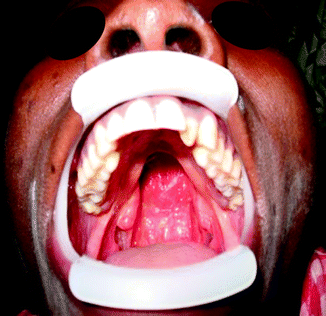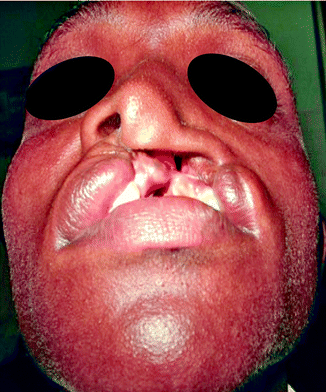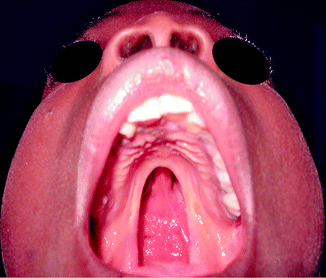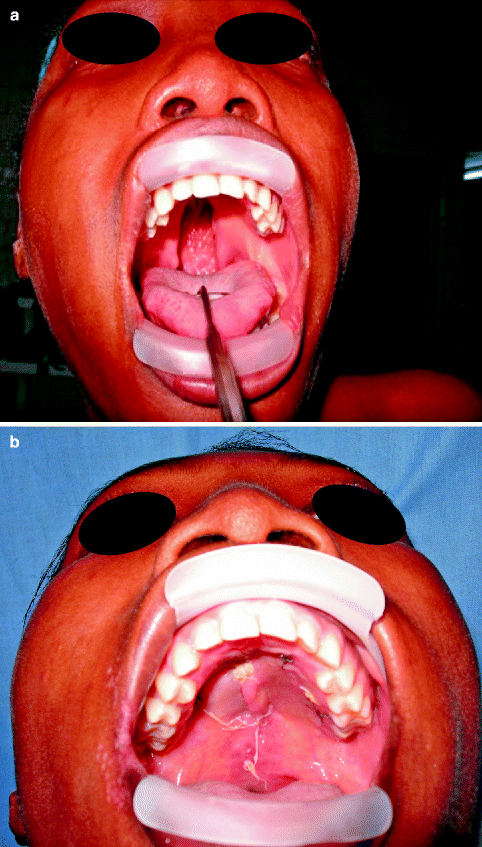Fig. 41.1
A graphical illustration of the frequency of applying single-stage cleft lip and palate repair
Four other centres claim that they carry out single-stage lip and palate repair routinely. Two of these centres carry out their procedure in children aged 10–18 months and above. Striking findings in this survey however were two other centres that would do complete lip and palate repairs in one sitting at 3 months (Hodges2010) and 6 months of age. Their usual techniques of palatoplasties were reported as Von Lagenbeck and Sommerland, respectively (Table41.1).
Table 41.1
Usual techniques of palate repair in African centres
|
Technique of palatoplasty
|
No. of centres (%)
|
|---|---|
|
Von Lagenbeck
|
14 (58.3)
|
|
Bardach
|
2(8.3)
|
|
Sommerland
|
2 (8.3)
|
|
V-Y push back
|
2 (8.3)
|
|
Von Lagenbeck–Furlow
|
2 (8.3)
|
|
Delaire–Lagenbeck
|
1 (4.2)
|
|
Intravelar veloplasty–vomerine flap
|
1 (4.2)
|
|
Total
|
24(99.9)
|
All centres however lack a long-term follow-up result to show their outcome.
Routine single-stage cleft lip and palate repair in the four centres identified was predicated on:
-
Avoidance of second surgery, thereby saving time and money
-
Eliminating the high likelihood of a patient defaulting after first stage
-
Satisfying parents’ desire for a “once for all procedure and fear of repeated operations”
One of the centres does this to keep the babies alive and to forestall anticipated malnutrition being speculated to have claimed the lives of many children (Wilson and Hodges2012).
Interestingly, one centre abandoned a single-stage lip and palate repair because of the excessive haemorrhage and severe post-operative morbidity encountered.
Surgeons that have never explored single-stage palatoplasty unanimously avoided it because they believe that early single-stage repair does tamper with facial growth.
Wide defects closed in a single stage predisposes to very extensive surgery, closure under tension and likelihood of wound breakdown (Fig.41.2).


Fig. 41.2
Wide palatal defect that will defy a successful single-stage repair
Additionally, they judge that the chances of post-operative respiratory embarrassment are higher.
The results of this survey paint a picture of the presence of extremes of scenarios and no long-term follow-up report. We opine that the current regular support from charity organizations and philanthropists may help to reduce drop-out rate and improve outcome of follow-up studies. These findings substantiate the variability and diversity in our practices and the very urgent need for a standardized protocol.
Our situation calls for attaining a balance with doing as much as possible to solve existing problems, yet getting optimal short- and long-term results.
41.5 Striking the Delicate Balance Between Aesthetics, Speech and Growth
The universal goal of CLP surgeries has been clearly spelt out (American Cleft Palate-Craniofacial Association1993). They include obtaining optimal aesthetic, speech, growth and hearing functions. The ideal timing and technique for palatoplasty remain an enigma. Proponents of early palatoplasty want it for better speech (Dorf and Curtin1987), while the advocates of delayed palatoplasty (especially hard palate repair) want it for better maxillofacial growth (Gillies and Kesley Fry1921; Hotz and Gnoinski1979).
A fair appraisal of the existing protocols reveals desires to achieve the universal goals in all patients by all surgeons despite prevailing circumstances. Doubtless, this end may have to be reached by various means; nevertheless, there is a need to strive for safety and excellence in outcomes. Striking a delicate balance entails meeting the immediate demands, but more importantly, the long-term consequence(s) of interventions must be given very serious considerations. Measurement of treatment outcome should be an integral part of cleft management, especially now when evidence-based medical care and treatment guidelines regarding the best practice are essential requirements in contemporary clinical practice (Mossey et al.2003).
In the absence of long-term outcomes of current practices in most developing countries of Africa, our practices can be scrutinized in the light of evidences available in the literatures.
The concept of missing palate due to malnutrition is a speculation; as such, there is a possibility that the palates may have been lost to parent’s perception, fear of surgery, etc. We advocate meticulous search for the missing palates and an authentic report of their whereabout. Agrawal and Panda (2011) reported palates resurfacing just before marriage or special occasions in the family.
If indeed these patients are being lost to malnutrition, an agenda that beefs up nutritional care should serve as an appropriate stopgap protocol until the child reaches maturity with improved health.
Furthermore, evidences from available literatures suggest that a single-stage repair at 3 months to keep the child alive through good nutrition may turn out to be “solving part of the problem and creating a new one”. While achieving our goals of early single-stage repair (including Von Lagenbeck palatoplasty) in these patients, available literatures suggest that we may also end up with good speech outcome, minimal scar, little or no experience of stigmatization initially and a markedly retruded middle face and a late onset stigmatization (Ross1987a,b,c,d,e).
41.6 A Proposed Protocol
Having established that there are many protocols, the clinics still need treatment protocol(s) that address their specific peculiar factors and yet guided by test of professional ethics. Additionally, this would go a long way in helping to bridge the gap in our practices.
In formulating a protocol for the developing countries, it is important for us to start off with the realization thatthe idealsare extremely desirable for the developing countries as for the developed:
-
What is proven good and proper for the developed world is indeed appropriate for the developing countries. The main goals are the psychosocial factors, facial growth, speech and dental alignment.
-
The peculiarities of the developing countries as stated earlier need to be incorporated into such protocols to make them acceptable to the parents and adult patients.
-
Each case should be handled on its individual merit (Berkowitz et al.2005) since no two patients are the same. Protocols should not be rigid, but mere guides to individualizing them.
-
Zero tolerance to compromise in safety and striving for long-term excellent outcome should be the goal.
-
Giving due recognition to very simple measures like counselling and the involvement of social health services (to improve motivation, enlightenment by additional education and accessibility) will help patients get their questions answered at any time, regardless of their remote locations. A telephone help line is a simple measure that may facilitate this.
-
As we evolve out of a huge backlog of adult patients, a passionate motivation at lip repair would go a long way to ensure patient’s return for palate surgery in due time.
-
An excellent primary surgery outcome would go a long way to get patients back. This will be enhanced by the support (prepaid care) received in most developing countries from international non-governmental organizations.
-
Surgical techniques that entail stripping of palatal mucosa in children are not desirable.
-
Granted that “what you do to start with depends on what was handed over to you especially in training”, there is the need to retrain the old, learn new techniques and shift ground as occasion demands.
-
The protocol proposed must be considerate of the patient’s safety. The attendant co-morbidity must not outweigh the benefits.
-
The big question always should be, “Considering the type of defect, anticipated duration of surgery, patient’s age, general health condition, available facilities, etc., how best can this procedure be planned and carried out?”
-
Over and above these factors, the training undergone by the cleft surgeon influences to a large extent the choice of the primary surgical schedule (Lee and Kim2003). Nonetheless, there is always a lot of room for modification based on learning new skills and concepts from well-respected colleagues.
The majority of the centres worldwide prefer to repair the cleft lip at 3–6 months of age and cleft palate at 6–18 months of age (Lee and Kim2003) Table41.2. Even within the same centre, different surgeons sometimes follow different time schedules and techniques (Shaw et al.1992). A situation where there are as many primary surgery protocols as there are cleft centres appears to be the rule rather than the exception.
Table 41.2
Primary surgical treatment protocols in different cleft centres in major studies in the literature
|
Year
|
Author
|
Country
|
Age at lip repair (months)
|
Age at palate repair (months)
|
|---|---|---|---|---|
|
Schweckendiek and Doz
|
Germany
|
–
|
sP 6–8, hP 12–14
|
|
|
Takkar and Gupta
|
India
|
3–6
|
18–24
|
|
|
Malek and Psuame
|
France
|
6
|
sP–3, hP 6 with lip repair
|
|
|
Freedlander et al.
|
Britain
|
Neonatal
|
–
|
|
|
Shaw et al.
|
USA
|
|||
|
Centre A
|
3–4
|
sP 9–15, hP 9 years
|
||
|
Centre B
|
Lip + Ant hP–2
|
post-hP + sP 22
|
||
|
Centre C
|
>6
|
12
|
||
|
Centre D
|
>6
|
<24
|
||
|
Centre E
|
Lip + Ant hP–3
|
post-hP 18–22
|
||
|
Centre F
|
4–6
|
12
|
||
|
Lee and Kim
|
Korea
|
2.5–3 months or <6
|
6–12 or 12–18
|
|
|
Weinfeld et al.
|
USA
|
3 or 3–6
|
–
|
|
|
Berkowitz et al.
|
USA
|
–
|
18–24
|
|
|
Flinn et al.
|
USA
|
|||
|
Centre A
|
3
|
|||
|
Centre B
|
6
|
sP–6, hP–18
|
||
|
Centre C
|
3
|
18
|
||
|
Noordhoff and Chen
|
Taiwan
|
3–5
|
11–12
|
|
|
Agrawal and Panda
|
India
|
9–12
|
6–9
|
The different time schedules in different centres are selected with specific objectives, which are mainly related to maxillofacial growth and/or speech development.
Most of the existing and published protocols are developed from and for the developed countries where many have a priority system favouring speech.
Although they strive for good dento-maxillofacial growth and psychosocial well-being, they are not always 100% successful at attaining this (Berkowitz2006).
Reiterating and re-emphasizing the developing country’s situation, there are many more factors to be considered in the surgical correction of congenital anomalies like CLP. Factors like lack of awareness, lack of funds, presence of domestic problems, “advised late surgery”, child’s illness, lack of operative facilities in nearby hospitals and associated anomalies are some of the causes of late arrival (Agrawal2007; Schwarz and Khadka2004). Similarly, patients in Uganda did not return for cleft palate repair because they did not seem to appreciate the importance of the palate in speech production (Hodges and Hodges2000).
Against the backdrop of the special considerations in developing countries,an ideal protocolmust be one that suits patients’ conditions without compromising overall long-term functional results in terms of speech and dento-maxillofacial growth. Simultaneously, it should improve the compliance for second surgery and not necessarily eliminate it. It should not be too taxing for children with relatively low body weight, borderline haemoglobin concentration and other related health challenges. It should not increase the number of surgical procedures and create burden for parents of low socioeconomic status. Agrawal and Panda (2011) in line with these objectives proposed palatoplasty at 6 months or at presentation (if 6 months or beyond). Lip repair follows preferably 3–6 months after the first surgery. This is similar to Malek’s protocol in which only soft palate is repaired at 2 months in a first surgery. Thereafter, the lip and hard palate are repaired at 6 months. The authors concluded that early closure of soft palate ensures normal language development and less middle ear complications (Malek and Psaume1983). Although this procedure has its advantages, it has many drawbacks as well involving the failure to have good, facial aesthetics and dental occlusion.




Fig. 41.3
Unilateral cleft lip and palate in a 20-year-old Nigerian male

Fig. 41.4
Isolated cleft palate in a 13-year-old female

Fig. 41.5
a, b Pre- and post-operative pictures of cleft palate repaired in one stage in a 25-year-old female Nigerian
This chapter proposes a two-part protocol with variable staging for cleft lip and palate repairs. Part one of the protocol looks into severity of patient’s defect, patient’s general health condition, patient or parent’s level of motivation and access to intensive care unit. From these parameters, a list of absolute contraindications and relative indications are generated.
The second part reflects on defect type and patient’s age at presentation. An interval of at least 3–6 months is proposed between stages of surgery.
This proposal allows options of delayed or early lip repair. It is envisaged that the final choice will depend on parents or patient’s position and attending surgeon’s definitive decision. While it is often believed that parents would always want lips repaired first as it addresses the bulk of stigma experienced, Agrawal and Panda (2011) were able to prove that this is not always true. They proposed a protocol with the cleft lip and anterior palate (with primary nasal correction) as a second surgery, and parents were well disposed to it.
Only 1.3 % parents requested for lip repair at 6 months of age and palate repair at 1 year. Using the drop-out rate as an index of success, there was a 32.58 % in the conventional protocol group (lip surgery first) and 14.24 % in the modified schedule group (palate first).
Working with these patients and parents for decades, Agrawal and Panda (2011) established that the majority of parents in developing countries are easy to counsel. Though they are concerned about the baby’s appearance, they readily resign the decision on protocol to the treating/ managing surgeon. Years of practise have proven that the drive for the second surgery is minimal if cleft lip is repaired first because the cleft palate is hidden inside the mouth. Consequently, the high drop-out rate was reported.
On the other hand, when soft palate repair is the first surgery, the drive for lip repair is maintained, and the compliance much better with a lower to nil drop-out rate.
41.6.1 Proposed Protocol
Stay updated, free dental videos. Join our Telegram channel

VIDEdental - Online dental courses


